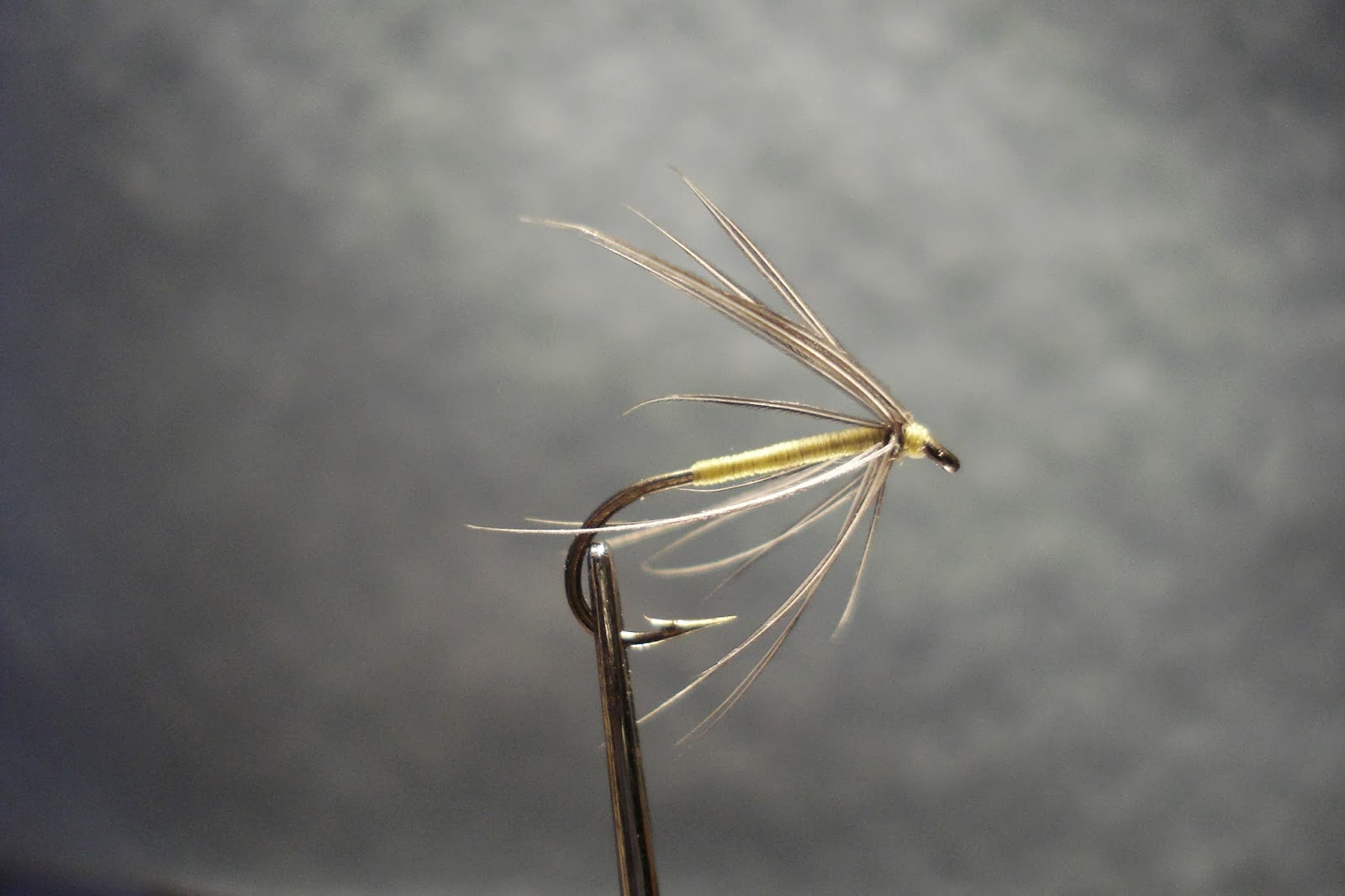 |
| Sylvester Nemes's March Brown Spider. |
Hook:
|
10-14
|
|
Body:
|
Mixed hair from hare’s face
|
|
Rib:
|
Narrow gold
|
|
Hackle:
|
Brown partridge
|
|
Tying Silk:
|
Orange
|
|
In the Soft-Hackled Fly (1975), Sylvester Nemes provides a dressing for a simple March Brown Spider that Dave Hughes includes in Wet Flies (1995). It incorporates many of the attributes of typical March Brown soft hackles: a brownish body, often of hare’s mask; a well-marked hackle, often partridge, but occasionally woodcock or grouse; and a prominent rib. (March Brown dressings often include wings. Even though I often included winged dressings and sometimes dress them as soft hackles, I will only mention winged patterns in passing.) Dressings of the March Brown are as numerous as the anglers who dress them and often include other names, like the Hackled Deul Cruik. These are a few. |
James Leisenring offers a
dressing of the March Brown Nymph that utilizes the coppery brown tone of
pheasant tail:
“HOOK 13.
SILK Orange.
HACKLE A
short-fibered, light brown feather from the Hungarian partridge.
TAIL Three fibers from a cock pheasant tail
feather tied very short.
RIB Gold or silver wire.
BODY Three reddish fibers from a center feather
of a cock pheasant’s tail. (As with peacock’s herl, tie in, twist with
thread, and wing up body, twisting together as you to.)
THORAX Hare’s ear fur dubbed fairly heavily.”
Harfield Edmonds and Norman Lee provide a
complicated dressing for the March Brown in their Brook and River Trouting (1916). It is No. 8b, tied on “Hook 2 or
3”:
“WINGS.-Hackled with a
mottle brown feather from a Snipe’s rump.
BODY.-Orange silk, No.
6a, dubbed with fur from the nape of a Rabbit’s neck which has been light
tinged red with Crawshaw’s Red Spinner dye, and ribbed with gold wire or
tinsel.
TAIL.-Two strands from
a feather from a Snipe’s rump, same feather as it used for the wings.
HEAD.-Orange silk.
April,
and often May.”
In his North-Country
Flies (1886), T. E. Pritt
offers five dressings, Nos. 11-15, for the March Brown, known alternately as
the Great Brown, Brown Drake, or Dun Drake. No. 13 is dressed as a hackle and
included in Fly Fishing: the
North-Country Tradition (1994) as one of Leslie Magee’s favorites. It is
dressed thus:
“HOOK 2.
WINGS.-Hackled, the
reddish feather from the outside of a Woodcock’s wing.
BODY.-Orange silk,
dubbed over with a little fur from a fox’s ear.”
Pritt notes that “many
anglers fish the March Brown, or a variation of it, more or less, all the
year round, lessening the size as the months go on and dressing it with a
lighter feather.”
John Jackson also list multiple patterns, all
winged wet flies, in his Practical Fly
Fisher (1853). His four patterns, under the heading “No. 8 Great Brown,”
vary to account for season or weather. Michael Theakston refers to the March
Brown as the Brown Drake, and represents it as the fifteenth fly in his List of Natural Flies (1853): “Wings,
a feather from under the wing of the hen pheasant; body, yellow silk, with a
few fibres of light fur from a hare’s ear, wrought in at the breast.” John
Turton includes a winged dressing of the March Brown as the first fly in his Angler’s Manual (1836).
The Bowlkers’ provided dressings for the March
Brown as their Brown Dun in The Art of
Angling (1758, 1774). Richard Bowlker’s dressing “is made of a partridge
or pheasant’s feather; the body of a patridge’s hackle with hair’s fur under
it, ribbed with yellow silk.” Charles’s dressing is very similar: the fly’s
“wings are made of the feathers of a pheasant’s wing, which is full of fine
shade, and exactly resembles the wing of the fly: The body is made of the
bright part of hares furr, mixed with a little of the red part of squirrels
furr, ribbed with yellow silk, and a partridges hackle wrapt twise or thrice
under the but of the wing”
|
John Waller Hills references James
Chetham’s Angler’s Vade Mecum
(1681) as the first text that mentions the March Brown. He explains that Chetham called it the
Moorish Brown, but the Moorish Brown is a later addition in a printing from
1700, wherein Chetham credits this fly as belonging to “Another Catalogue, of
Flies, practiced by a very good Angler, and useful to be known by the young
Anglers in clear, Stony Rivers.” The Moorish Brown is “Dub’d of the Wooll
of a Black Sheep and Red Silk, Wings of the Feather got from a Partridge
Wings.” Hills prefers Chetham’s pattern and writes “I rather like Chetham’s
pattern, for black sheep’s wool is brown when held up to the light, and if spun
on red silk might give the reddish brown of the body which is so hard to
copy. And then a partridge quill feather is good. The perfect fly is still to
come, but meantime it is worth noticing how little it has changed in what is
nearly two centuries and a half.”
|



